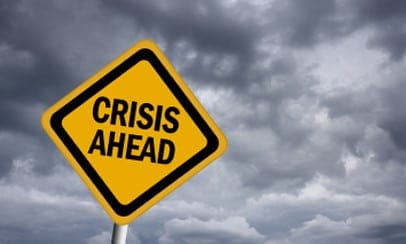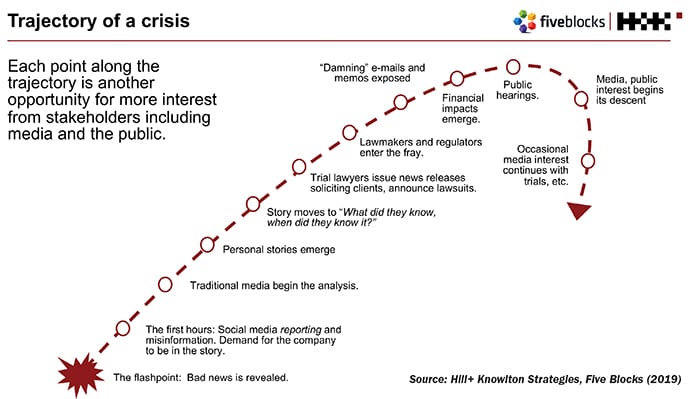
[Editor’s Note: This month our regular “Stealable Slide” feature offers the crisis-management advice of one of the deans of the subject, Kevin Elliott, U.S. director, risk+crisis communication practice, Hill+Knowlton Strategies. The slide below was presented during PRNEWS’ Crisis Management Summit in Miami Beach in early March.]
We presented research last fall from Pentland Analytics that argues a crisis, when handled well, actually can bolster a brand’s reputation and lead to financial gains (see PRNEWS, Oct. 2018). The opposite is true--a crisis handled poorly can lead to financial damage. With so much at stake, you’d think most companies would take significant action to mitigate risk. Not so.
Hidden Lesson
The slide below illustrates this point; however, the lesson comes from what’s not shown on the slide. It’s what happens (or doesn’t) before the trajectory on the slide begins.
For example, let’s say a company conducts it annual risk assessment. The company finds seven areas of risk. “It’s great that the company is looking at risk,” Elliott says, “but you come back one year later and they’ve done nothing to fix those seven risk areas...and now they’ve added three more.”
In some cases, Elliott says, companies think they’re preparing when they hire crisis-savvy personnel or devise an elaborate crisis-response plan. Elliott welcomes such preparation, but urges companies also “do things operationally” to mitigate risks they’ve found during their risk assessment.
“Most crises don’t happen overnight...there usually are warning signs,” he says. Attacking risk mitigation via operational changes may help avoid reaching the flashpoint, which is the first stage seen on this slide (lower left). So the work done before the flashpoint is what Elliott believes is most crucial.
Realizing how badly a crisis can hurt a company’s bottom line argues that “you can’t afford not to invest to reduce your risk” areas, he says.

The Trajectory
The slide’s graphic depiction of a crisis is an approximation. Sometimes the shape of the curve is flatter, in other instances it’s sharper. “You never know...sometimes news dribbles out daily, lawsuits occur and then one day something else hits the news and the media forgets about your crisis,” he says.
Still, looking at the slide, Elliott points out that the narrative, or trajectory, of a crisis can move at lightning speed since social media is propelling it. “It’s moment to moment...in the old days it could be days or weeks before a story came out.” As the crisis advances and you move up the trajectory, “the question becomes what did the company know and when? And it really comes fast.” He agrees with us that the Boeing 737 Max 8 crisis can be charted using the trajectory on this slide.
In the Boeing case, Elliott makes a point about speed cutting both ways. Not only does news about the crisis pile up quickly, experts, or so-called experts, posit solutions at breakneck speed, too. “A lot of the time the solutions come before there’s enough information known about the crisis,”he says. Still, those opinions need to be monitored, if not reacted to, Elliott adds. Often at this point, a crisis, which might have been limited to industry followers, becomes a mass-media story and wall-to-wall coverage begins. Boeing wasn’t ready for that, as Katie Paine notes on page 10. Eventually intense media interest declines (top right of the slide).
Another lesson from this slide, he says, is that “every phase along the trajectory is an opportunity” for a company “to communicate, to reach audiences, to rebuild trust in the brand...and eventually resume normal operations.” Ignoring what occurs along the trajectory or mishandling it, of course, provides opportunities for others to frame your narrative, which can prolong and deepen the crisis.
Another important point Elliott made during his session: Expect boards to be involved sooner and more directly in crises. With the public’s expectations of brands rising, its demand for transparency also will increase, he says. “Stakeholders will be reaching out directly to board members.” Brands should train board members to know how to react to this type of outreach.
CONTACT: Shelcie.Kalinowski@hkstrategies.com
